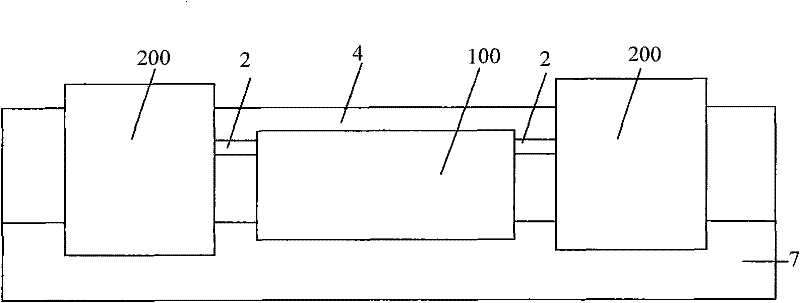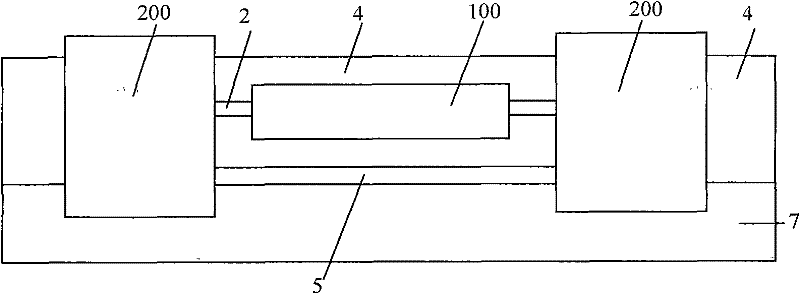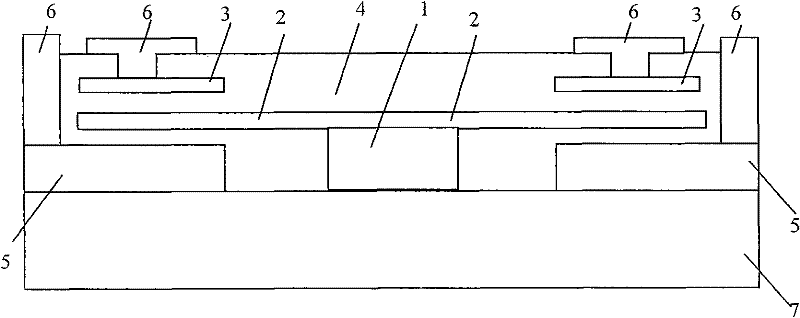Nonvolatile semiconductor photorefractive memory structure
A non-volatile, semiconductor technology, applied in the field of medium refractive index, can solve the problems of small coupling part, low efficiency, weak refractive index of optical waveguide, etc., and achieve the effect of energy saving, high efficiency and broad application prospects
- Summary
- Abstract
- Description
- Claims
- Application Information
AI Technical Summary
Problems solved by technology
Method used
Image
Examples
Embodiment 1
[0028] Example 1 Overall structure of the present invention
[0029] figure 1 , 2 , 3 gives the overall structure of the present invention from different angles. In the figure, 100 is the optical waveguide part, 200 is the floating gate part, 1 is the semiconductor optical waveguide, 2 is the floating gate, 3 is the control gate, 4 is the upper insulator medium, 5 is the conductive medium, 6 is the electrode, 7 is the lower insulator medium.
[0030] The nonvolatile semiconductor photorefractive memory structure of the present invention is composed of an optical waveguide part 100 and a floating gate part 200. in figure 1 , 2 In the structure shown in 3, there are two floating gate portions 200. Among them, the optical waveguide section 100 is composed of a semiconductor optical waveguide 1, an upper insulator medium 4 above the semiconductor optical waveguide 1, and a lower insulator medium 7 below the semiconductor optical waveguide 1; the floating gate section 200 is made up o...
Embodiment 2
[0033] Embodiment 2 Different structure of optical waveguide part 100
[0034] Figure 4 , 5 , 6, and 7 respectively show the optical waveguide part 100 of different structures.
[0035] Figure 4 As shown, the semiconductor optical waveguide 1 is a strip waveguide, the floating gate 2 is in direct contact with the semiconductor optical waveguide 1, and the floating gates 2 in the two floating gate portions are connected together. The upper insulator medium 4 and the lower insulator medium 7 electrically isolate the semiconductor optical waveguide 1 and the floating gate 2 from other components.
[0036] Figure 5 As shown, the semiconductor optical waveguide 1 is a ridge waveguide, the floating gate 2 is in direct contact with the semiconductor optical waveguide 1 on the ridge of the semiconductor optical waveguide 1, and the rest are the same. Figure 4 .
[0037] Image 6 As shown, the semiconductor optical waveguide 1 is an inverted ridge waveguide, the floating gate 2 is in direc...
Embodiment 3
[0040] Embodiment 3 Different structures of floating gate portion 200
[0041] Figure 8 with Picture 9 The structure of one floating gate portion 200 is drawn each. The position of each component is that one electrode 6 contacts the control gate 3, the floating gate 2 is underneath, and the conductive medium 5 is underneath. The conductive medium 5 is in contact with the other electrode 6; the floating gate 2, the control gate 3 and the conductive medium 5 are connected from above. The insulator medium 4 is electrically isolated.
[0042] Figure 8 versus Picture 9 The only difference is that the conductive medium 5 is only in its own floating gate part 200 (such as Figure 8 Shown) and the conductive medium 5 stretched out of its own floating gate portion 200 (such as Picture 9 The middle conductive medium 5 is shown at the left end), which can be integrated with another conductive medium 5 and electrically isolated from the semiconductor optical waveguide 1.
PUM
 Login to View More
Login to View More Abstract
Description
Claims
Application Information
 Login to View More
Login to View More - R&D
- Intellectual Property
- Life Sciences
- Materials
- Tech Scout
- Unparalleled Data Quality
- Higher Quality Content
- 60% Fewer Hallucinations
Browse by: Latest US Patents, China's latest patents, Technical Efficacy Thesaurus, Application Domain, Technology Topic, Popular Technical Reports.
© 2025 PatSnap. All rights reserved.Legal|Privacy policy|Modern Slavery Act Transparency Statement|Sitemap|About US| Contact US: help@patsnap.com



